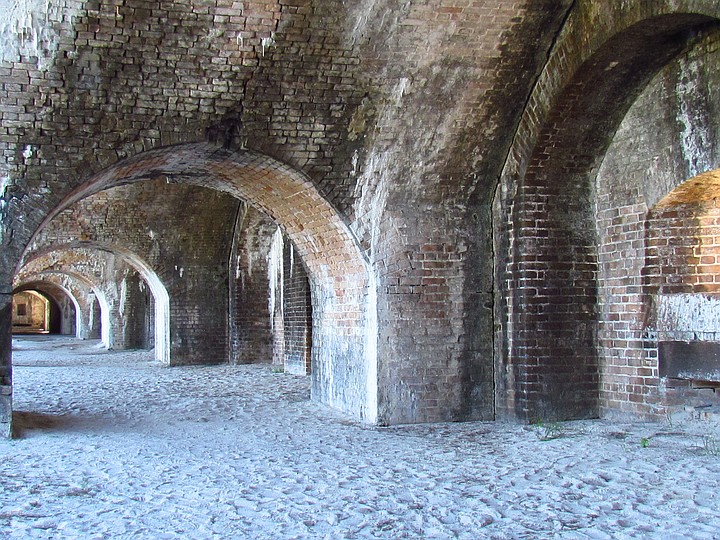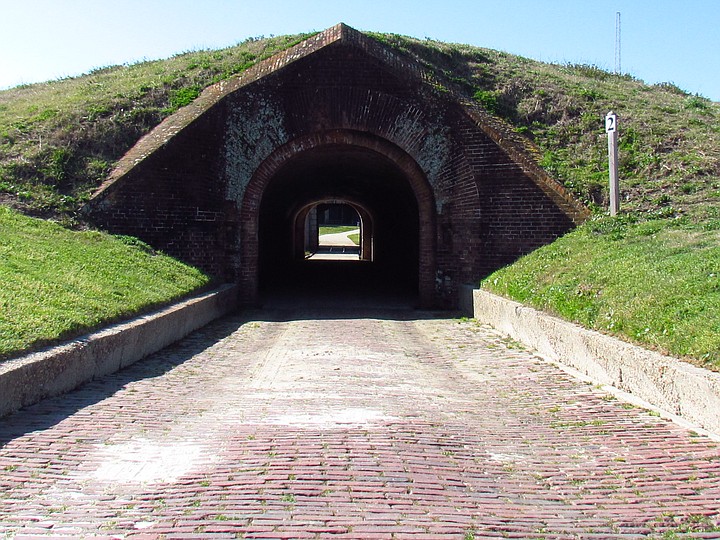 Facebook
Facebook
 X
X
 Instagram
Instagram
 TikTok
TikTok
 Youtube
Youtube

Empires rise and they fall, leaving behind the ruins of their fortresses. Until armored warships rendered masonry forts and their black powder cannons obsolete, warring European empires set on colonizing the rest of the world dotted the planet with brick-and-stone battlements, beginning with those erected at first landfall.
Typically, it only took a few decades for the native population to be diminished by 80 percent due to disease and sometimes-violent evangelism.
Although a young country, the periphery of the United States is studded with remnants of these colonial fortresses, some of which can only be reached by boat. From Fort Knox in Maine to Fort Flagler in Washington, from El Morro in Puerto Rico to Fort Kamehameha in Hawaii, war buffs have ample fodder with which to plan coastal tours of historic forts.
In fact, the quintessential freedom fighter Geronimo, along with his entourage, was held in several of those along the Gulf of Mexico, lending a themed itinerary stretching from the Atlantic coast all the way to Geronimo’s stronghold in the Dragoon Mountains in Texas Canyon, Arizona.
I’ve crossed the continent nine times, twice hugging the coastline, once hopping its barrier islands following the Mississippi Flyway. While so doing, I visited numerous forts sheltered by the dunes, beginning at Fort Cinch on gorgeous antiquated Amelia Island on Florida’s Atlantic coast and ending at Fort Massachusetts in Mississippi.
Perhaps the most famous of the forts I’ve seen is St. Augustine’s 17th-century bastion, Castillo de San Marcos, the oldest masonry fortification in North America. It was constructed originally to defend Spanish treasure fleets against pirates. With my prepaid annual Federal Interagency Pass in hand, I managed to bypass the long admission lines.
The star-shaped Castillo was constructed from the only stone locally available – a semi-rare form of limestone called coquina. The lightweight porous material had an unexpected absorption quality. As a geological conglomerate comprised of tiny shells, coquina has microscopic air pockets, making it compressible. When fired upon, therefore, it doesn’t shatter into shards as brick or stone walls do. Unknown to the architects, cannon balls fired at the Castillo were literally swallowed by the walls they had meant to penetrate.
And, although certainly not the only fort to utilize earthen berms or native vegetative camouflage, the Spanish, interestingly, armed the base as well as the ramparts of the Castillo with a 20-foot hedge of yucca, its razor-sharp spear-shaped leaves referred to as the Spanish Bayonet.
Don’t leave the Castillo without hunting down the Apache fire god etched into the walls.

Fort Pickens, preserved within the Gulf Islands National Seashore, is situated on the gorgeous 40-mile Santa Rosa Island south of Pensacola. It, too, is fairly popular, but it's got a fun byline attached to it. Apparently, a handfull of Irish enlistees stationed at the Union-occupied pentagonal fort (one of five so designed along Pensacola Bay) had been shunned to the outer batteries due to their drunken rowdiness. Being divided from the rest of their company, it was they who held off the Confederate army’s surprise nighttime attack until backup arrived from the fort, having heard the prolonged gunfire.
If you're like me and prefer your history without throngs of tourists so you can hear the whispering winds of time, trek to the much-less frequented forts only accessibly by boat.

Fort Jefferson off of Key West is tucked within the islands and shoals of Dry Tortugas where it patrolled the Straits of Florida, the gateway into the Gulf. Likewise, Fort Massachusetts, engulfed by a 30-foot storm surge during Hurricane Katrina, is perched on West Ship Island 12 miles off the Mississippi coastline. State-run hobbit hole Fort Morgan (left) at the ferry dock for Dauphin Island, west of Gulf Shores, Alabama, is also relatively unfrequented.


Empires rise and they fall, leaving behind the ruins of their fortresses. Until armored warships rendered masonry forts and their black powder cannons obsolete, warring European empires set on colonizing the rest of the world dotted the planet with brick-and-stone battlements, beginning with those erected at first landfall.
Typically, it only took a few decades for the native population to be diminished by 80 percent due to disease and sometimes-violent evangelism.
Although a young country, the periphery of the United States is studded with remnants of these colonial fortresses, some of which can only be reached by boat. From Fort Knox in Maine to Fort Flagler in Washington, from El Morro in Puerto Rico to Fort Kamehameha in Hawaii, war buffs have ample fodder with which to plan coastal tours of historic forts.
In fact, the quintessential freedom fighter Geronimo, along with his entourage, was held in several of those along the Gulf of Mexico, lending a themed itinerary stretching from the Atlantic coast all the way to Geronimo’s stronghold in the Dragoon Mountains in Texas Canyon, Arizona.
I’ve crossed the continent nine times, twice hugging the coastline, once hopping its barrier islands following the Mississippi Flyway. While so doing, I visited numerous forts sheltered by the dunes, beginning at Fort Cinch on gorgeous antiquated Amelia Island on Florida’s Atlantic coast and ending at Fort Massachusetts in Mississippi.
Perhaps the most famous of the forts I’ve seen is St. Augustine’s 17th-century bastion, Castillo de San Marcos, the oldest masonry fortification in North America. It was constructed originally to defend Spanish treasure fleets against pirates. With my prepaid annual Federal Interagency Pass in hand, I managed to bypass the long admission lines.
The star-shaped Castillo was constructed from the only stone locally available – a semi-rare form of limestone called coquina. The lightweight porous material had an unexpected absorption quality. As a geological conglomerate comprised of tiny shells, coquina has microscopic air pockets, making it compressible. When fired upon, therefore, it doesn’t shatter into shards as brick or stone walls do. Unknown to the architects, cannon balls fired at the Castillo were literally swallowed by the walls they had meant to penetrate.
And, although certainly not the only fort to utilize earthen berms or native vegetative camouflage, the Spanish, interestingly, armed the base as well as the ramparts of the Castillo with a 20-foot hedge of yucca, its razor-sharp spear-shaped leaves referred to as the Spanish Bayonet.
Don’t leave the Castillo without hunting down the Apache fire god etched into the walls.

Fort Pickens, preserved within the Gulf Islands National Seashore, is situated on the gorgeous 40-mile Santa Rosa Island south of Pensacola. It, too, is fairly popular, but it's got a fun byline attached to it. Apparently, a handfull of Irish enlistees stationed at the Union-occupied pentagonal fort (one of five so designed along Pensacola Bay) had been shunned to the outer batteries due to their drunken rowdiness. Being divided from the rest of their company, it was they who held off the Confederate army’s surprise nighttime attack until backup arrived from the fort, having heard the prolonged gunfire.
If you're like me and prefer your history without throngs of tourists so you can hear the whispering winds of time, trek to the much-less frequented forts only accessibly by boat.

Fort Jefferson off of Key West is tucked within the islands and shoals of Dry Tortugas where it patrolled the Straits of Florida, the gateway into the Gulf. Likewise, Fort Massachusetts, engulfed by a 30-foot storm surge during Hurricane Katrina, is perched on West Ship Island 12 miles off the Mississippi coastline. State-run hobbit hole Fort Morgan (left) at the ferry dock for Dauphin Island, west of Gulf Shores, Alabama, is also relatively unfrequented.
Comments